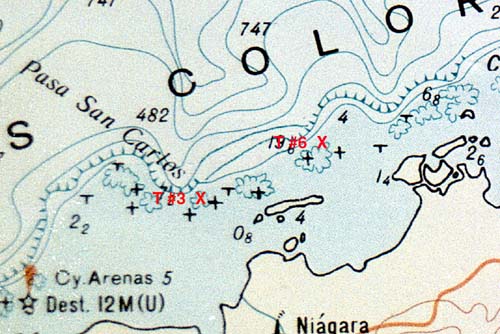

INDEX: Cayo Levisa
Cuba Report - Index Cayo Levisa

If the biota, in the course of aeons, has built something we like but do not understand, then who but a fool would discard seemingly useless parts? To keep every cog and wheel is the first precaution of intelligent tinkering. Aldo Leopold, Round River, 1993.
Reef Relief Founders.com
full-cuba-report-with-links
full-cuba-report-with-links
Cayo Levisa was the first island in the Archipielago de los Colorados that a cruising boat approaching from Havana is allowed to visit. The eastern entry to this island passes through the reef at a deep cut called Pasa San Carlos. The shallow coral reef was clearly visible near the entry marker so we chose to make this reef transect #3. There is a small resort development on the island catering to foreign as well as local tourists. The Cuban mainland, which is dominated by tobacco farms, is very close to the coral reefs that fringe the northern side of Cayo Levisa.
Cruising and Diving Notes from the Log of Stormy Weather
Cayo Levisa June 6, l998 transect #3 water green
Transect #6 was located due east of the sea buoy marking Quebrada San Carlos, the western approach to Cayo Levisa, which is marked on the charts N22 53 00 W 83 34 00.
This reef sits on a shelf very near to deep water. This reef was dominated by a yellow turf algae approximately 4cm in height. This yellow algae was also growing on sea fans and other gorgonians in this area. There was one large patch of Acropora palmata along with many other isolated palmata colonies. Dozens of Coralliophila could be found on each colony suggesting that the white spots observed on the coral were due to snail grazing. Many of the sea fans exhibited signs of Aspergillosis.
Cayo Levisa June 9, l998 transect #6 water green
This dive was located north east of Cayo Levisa at N 22 54. 179 W083 30. 866 on a reef marked on the chart. This reef is very close to a deep drop off on a plateau ranging from six feet to thirty feet. On the ledge of the embankment there was a wide variety of coral species dominated by macroalgae. A ‘stop light' parrot fish was observed with fish lesions similar to infected fish that were seen in Palm Beach, Florida during the summer of 1987. The Acropora palmata observed were not very healthy and the sea fans displayed symptoms of aspergillosis. Coral bleaching was evident on the Diploria clivosa but not pronounced on other species of coral. White plague was also present on the small Montastrea colonies. The Dichocoenia stokesi looked very healthy. At another reef close to this one we snorkeled without laying a transect. No sea urchins or commercial species of fish were seen. We did see a spear fisherman at the resort indicating that these reefs are fished. Tobacco farming is within a couple of miles from this area. There was an abundance of Coralliophila on the few colonies of Acropora palmata at this reef.




